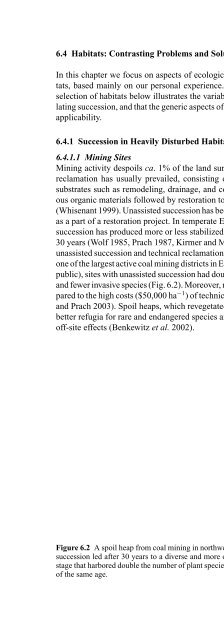Linking Restoration and Ecological Succession (Springer ... - Inecol
Linking Restoration and Ecological Succession (Springer ... - Inecol
Linking Restoration and Ecological Succession (Springer ... - Inecol
You also want an ePaper? Increase the reach of your titles
YUMPU automatically turns print PDFs into web optimized ePapers that Google loves.
6.4 Habitats: Contrasting Problems <strong>and</strong> Solutions<br />
In this chapter we focus on aspects of ecological restoration in selected habitats,<br />
based mainly on our personal experience. However, we believe that the<br />
selection of habitats below illustrates the variability <strong>and</strong> potential for manipulating<br />
succession, <strong>and</strong> that the generic aspects of these case studies have a wider<br />
applicability.<br />
6.4.1 <strong>Succession</strong> in Heavily Disturbed Habitats<br />
6.4.1.1 Mining Sites<br />
Mining activity despoils ca. 1% of the l<strong>and</strong> surface (Walker 1999). Technical<br />
reclamation has usually prevailed, consisting of rough manipulations of the<br />
substrates such as remodeling, drainage, <strong>and</strong> covering the surface using various<br />
organic materials followed by restoration toward either grassl<strong>and</strong> or forest<br />
(Whisenant 1999). Unassisted succession has been rarely included intentionally<br />
as a part of a restoration project. In temperate Europe, for example, unassisted<br />
succession has produced more or less stabilized, seminatural vegetation in 20–<br />
30 years (Wolf 1985, Prach 1987, Kirmer <strong>and</strong> Mahn 2001). In a comparison of<br />
unassisted succession <strong>and</strong> technical reclamation schemes on coal spoil heaps in<br />
one of the largest active coal mining districts in Europe (northwestern Czech Republic),<br />
sites with unassisted succession had double the number of plant species<br />
<strong>and</strong> fewer invasive species (Fig. 6.2). Moreover, no investment was needed compared<br />
to the high costs ($50,000 ha−1 ) of technically reclaimed sites (Hodačová<br />
<strong>and</strong> Prach 2003). Spoil heaps, which revegetated spontaneously, also provided<br />
better refugia for rare <strong>and</strong> endangered species <strong>and</strong> did not exhibit any negative<br />
off-site effects (Benkewitz et al. 2002).<br />
Figure 6.2 A spoil heap from coal mining in northwestern Czech Republic. Unassisted<br />
succession led after 30 years to a diverse <strong>and</strong> more or less stabilized late successional<br />
stage that harbored double the number of plant species than technically reclaimed heaps<br />
of the same age.<br />
Chapter 6 Manipulation of <strong>Succession</strong> 127

















